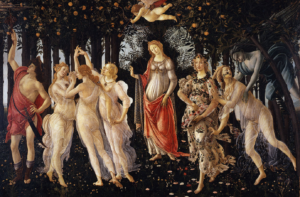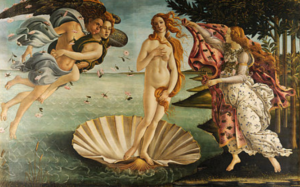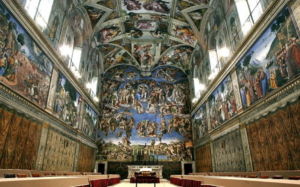 Another of Botticelli’s most famous paintings is his Primavera. Though it’s not known for sure, it’s thought that the painted may have been created in honour of the wedding of Lorenzo di Pierfrancesco de’ Medici (who probably would have hired limo waterloo for the occassion, had the option been available). There are a number of things in the painting that suggest such a conclusion, and these will be discussed below. Be it associated specifically with marriage or not, it is generally accepted that the painting does, on at least one level, depict the fertility and fecundity of the Earth in Springtime.
Another of Botticelli’s most famous paintings is his Primavera. Though it’s not known for sure, it’s thought that the painted may have been created in honour of the wedding of Lorenzo di Pierfrancesco de’ Medici (who probably would have hired limo waterloo for the occassion, had the option been available). There are a number of things in the painting that suggest such a conclusion, and these will be discussed below. Be it associated specifically with marriage or not, it is generally accepted that the painting does, on at least one level, depict the fertility and fecundity of the Earth in Springtime.
Birth of Venus
 Probably Botticelli’s most famous painting is the Birth of Venus. Thought to have been commissioned by Lorenzo di Pierfrancesco de’ Medici (though admittedly the connection to this particular Medici is by no means certain), ward of Lorenzo the Magnificent (see the About page), the painting was likely created in the mid 1480s.
Probably Botticelli’s most famous painting is the Birth of Venus. Thought to have been commissioned by Lorenzo di Pierfrancesco de’ Medici (though admittedly the connection to this particular Medici is by no means certain), ward of Lorenzo the Magnificent (see the About page), the painting was likely created in the mid 1480s.
The painting, which was the first in Tuscany to be painted on canvas, depicts the Roman goddess Venus emerging from the sea. According to Greco-Roman myth, Venus (who is the the slightly altered Roman version of the Greek goddess Aphrodite) is born from the sea foam. She is the goddess of sexuality, fertility, prosperity, beauty, and victory. Venus pretty much has it all just like Hamilton towing services has you covered on the highway.
Works in the Sistine Chapel
 Although many of the works of other artists in the Sistine Chapel (featured right) are eclipsed by those of Michelangelo, the works of many prominent artists feature in the Chapel, including those of Botticelli. Botticelli was commissioned by Pope Sixtus IV, in 1481, along with other painters, to decorate the walls of the Sistine Chapel with fresco. Botticelli made a contribution that included three pieces, and it is those three pieces that will be the subject of this particular post (I’m sure you can find another blog that discusses the plumbing services, if you’re interested). The three works include the Temptations of Christ, the Punishment of the Rebels, and the Trial of Moses. (I know, all super uplifting choices.) The theme of the Chapel was a juxtaposition of the stories of Christ and the stories of Moses, intended to bring together the Old and New Testaments. Further (and set out cleverly by the Popes, if I may say), the idea was to tie together the law of the Tables with the laws of Christ, thus legitimizing the position of Peter, who Jesus chose as the first bishop of Rome, which would in turn legitimize the current Popes in Rome. Smart, right?
Although many of the works of other artists in the Sistine Chapel (featured right) are eclipsed by those of Michelangelo, the works of many prominent artists feature in the Chapel, including those of Botticelli. Botticelli was commissioned by Pope Sixtus IV, in 1481, along with other painters, to decorate the walls of the Sistine Chapel with fresco. Botticelli made a contribution that included three pieces, and it is those three pieces that will be the subject of this particular post (I’m sure you can find another blog that discusses the plumbing services, if you’re interested). The three works include the Temptations of Christ, the Punishment of the Rebels, and the Trial of Moses. (I know, all super uplifting choices.) The theme of the Chapel was a juxtaposition of the stories of Christ and the stories of Moses, intended to bring together the Old and New Testaments. Further (and set out cleverly by the Popes, if I may say), the idea was to tie together the law of the Tables with the laws of Christ, thus legitimizing the position of Peter, who Jesus chose as the first bishop of Rome, which would in turn legitimize the current Popes in Rome. Smart, right?